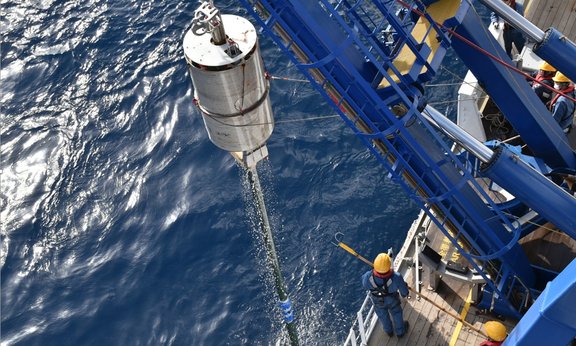Two records in scientific ocean drilling were broken during the expedition: the deepest site below sea level ever drilled and cored at a water depth of 8,023 meters and the deepest sub-sea level sample taken at 8,061 mbsl (meters below sea level). Giant earthquakes occur at convergent plate boundaries where oceanic plates are subducted below overriding plates. Due to the downward bending of the oceanic plates, these plate boundaries form oceanic trenches, the deepest places on our planet, at water depths far below 6,000 meters. All expedition participants will meet in Japan in the Autumn for the second part of the expedition to examine and analyse the cores. Co-chief Scientist Michael Strasser explains: “To study giant earthquake history and processes along subduction plate boundaries, we have to access the sedimentary records from these ultra-deepwater environments. With the new Giant Piston Corer System onboard the R/V Kaimei it has now become possible to efficiently and safely sample the deeper subsurface in these environments.” The expedition successfully recovered 832 meters of cores recovered from a total of 15 Sites and 58 holes cored along the entire Japan Trench from 36°N to 40.5 N, in water depths ranging from 7,445 to 8,023 mbsl. “IODP Expedition 386 Site M0081, where the water depth is 8,023 meters, now – after more than forty-three years – breaks the record as the deepest site below sea level drilled and cored in scientific ocean drilling history. We greatly acknowledge the tremendous efforts of the Captain of the R/V Kaimai and his crew to safely carry out such challenging ultra-deepwater coring operations and look forward to now undertaking scientific analyses on these samples from the deepest of the deep,” says Michael Strasser, head of the Sedimentary Geology working group at the Department of Geology and the Austrian Core Facility for scientific core analysis at the University of Innsbruck.
Possible candidates for past great earthquakes
Co-chief Scientist Ken Ikehara adds: “It was really a tough expedition. Many atmospheric low pressure systems and unexpectedly strong Kuroshio Current got in our way. However, we obtained giant piston cores from 15 sites along entire Japan Trench. Preliminary observations and onboard measurements of these cores suggest that we could recover good cores, which we believe contain event deposits with decimeter- to several meter-thickness. These event deposits are possible candidates for past great earthquakes along the Japan Trench. We expect that further analyses of these cores during the onshore sampling party and thereafter will contribute to understanding the spatio-temporal variation of great earthquakes and earthquake-related material transport along the Japan Trench, and to establishing methodology of deep-sea paleoseismology.”
The expedition was operated by the ECORD Science Operator in close collaboration with the Institute for Marine-Earth Exploration and Engineering (MarE3) within the Japan Agency for Marine-Earth Science and Technology (JAMSTEC).
Implementing this expedition has been a great challenge. Due to the ongoing pandemic and global travel restrictions, the offshore phase could not be carried out as planned with international scientists. Through the efforts of the Japanese team from MarE3, JAMSTEC, it was possible to fulfil the expedition scientific objectives with solely Japanese staffing. Through careful planning and adopting best hygienic practices, all participants were kept safe and healthy from possible COVID-19 infection.
International team
The successful offshore phase will now be followed by an onshore phase this autumn. 35 scientists with expertise in different geoscience disciplines from Austria, Australia, China, Finland, France, Germany, India, Japan, Korea, Sweden, UK, and the United States participate in IODP Expedition 386. The whole international science team will meet for the first time in the autumn on board the drilling vessel Chikyu, whose laboratory infrastructure will be utilized for intensive investigation and sampling of the cores onshore while the ship is in port. This will involve splitting, describing, analyzing, and sampling the cores, and combining the resulting data with that collected during the offshore phase to compile a comprehensive expedition scientific report. The curated cores and samples will then be a focus for further state-of-the-art analyses by the wider international science community for many years to come.

